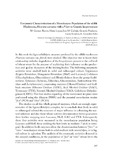Mostrar el registro sencillo del ítem
Enzymatic characterization of a monokaryon population of the edible mushroom, Pleurotus ostreatus with a view to genetic improvement
| dc.creator | Terrón, María del Carmen | es_ES |
| dc.creator | López, María | es_ES |
| dc.creator | Carbajo, José M. | es_ES |
| dc.creator | Pisabarro de Lucas, Gerardo | es_ES |
| dc.creator | Ramírez Nasto, Lucía | es_ES |
| dc.creator | González Aldo, E. | es_ES |
| dc.date.accessioned | 2018-02-15T10:32:27Z | |
| dc.date.available | 2018-02-15T10:32:27Z | |
| dc.date.issued | 2006 | |
| dc.identifier.isbn | 84-9769-107-5 | |
| dc.identifier.uri | https://hdl.handle.net/2454/27277 | |
| dc.description | Resumen del poster presentado al VI Meeting on Genetics and Cellular Biology of Basidiomycetes (GCBB-VI), organizado por y celebrado en la Universidad Pública de Navarra el 3-6 de junio de 2005. | es_ES |
| dc.description.abstract | In this work the lignocellulolytic enzymes produced by the edible mushroom Pleurotus ostreatus var. florida were studied. The objective was to know their relationship with the degradation of the biopolymers present in the cell wall of wheat-straw for the purpose of explaining their influence on the production and quality characters of the fruiting bodies. The following enzymatic activities were studied both in solid and submerged culture: Ligninases (Lignin Peroxidase, Manganese Peroxidase (MnP) and Laccase), Cellulases (Glucohydrolases, Glucosidases) and Hemicellulases from the group Arabinofuran- Xylanases (Xylanase, Xilosidase, Glucoronidase, Arabinofuran-Oxidase and Acetylesterase), cooperating enzymes (Glyoxal Oxidase) and feedback enzymes (Glucose Oxidase (GOD), Aryl Alcohol Oxidase (AAO), Tyrosinase (TYR), Veratryl Alcohol Oxydase (VAO), Cellobiose Dehydrogenase (CDH)). The first studies regarding all the mentioned enzymes were performed using the dikayon (N001) and the parental monokarion strains “fast” (PC9) and “slow” (PC15). The studies on all this whole group of enzymes, which are enough representative of the lignocellulolytic complex, let to conclude that (both in solid or submerged culture) the enzymes of major influence in colonizing the natural substrate and also those whose activity-determination better guarantees their further mapping were Laccases, MnP, AAO and TYR. Subsequently these four activities were measured in the monokaryon population being Laccases and MnP, those yielding the best levels in medium-7 (rich in nitrogen). In addition both enzymes allow the discrimination between “fast-” or “slow-” monokaryon strains both in solid medium with several dyes, or in liquid culture in agitation. The analysis of the enzymatic activities detected in the assayed conditions, in the population of “fast” or “slow” strains let to the observation that they map in different places where the loci corresponding to Laccase (pox) and mnp genes are located. These results open the possibility to design more precise studies that could help to establish a correlation between the contribution of the genes already described and the activity of the different ligninolytic enzymes. In addition the results will contribute to know whether in P. ostreatus genome there are new genes or if they correspond with locations that regulate these enzymatic activities, or it is a gene that has a role in the transport system or a kind of effector in the exportation machinery of the protein to the culture medium. | en |
| dc.format.extent | 2 p. | |
| dc.format.mimetype | application/pdf | en |
| dc.language.iso | eng | en |
| dc.publisher | Universidad Pública de Navarra / Nafarroako Unibertsitate Publikoa | es |
| dc.relation.ispartof | Antonio G. Pisabarro and Lucía Ramírez (eds.): VI Meeting on Genetics and Cellular Biology of Basidiomycetes (GCBB-VI). Pamplona: Universidad Pública de Navarra / Nafarroako Unibertsitate Publikoa, 2006. | es |
| dc.rights | © Autores; Universidad Pública de Navarra. Esta publicación no puede ser reproducida, almacenada o transmitida total o parcialmente, sea cual fuere el medio y el procedimiento, incluidas las fotocopias, sin permiso previo concedido por escrito por los titulares del copyright. | es_ES |
| dc.subject | Pleurotus ostreatus var. Florida | en |
| dc.subject | Lignocellulolytic enzymes | en |
| dc.title | Enzymatic characterization of a monokaryon population of the edible mushroom, Pleurotus ostreatus with a view to genetic improvement | en |
| dc.type | info:eu-repo/semantics/conferenceObject | en |
| dc.type | Contribución a congreso / Biltzarrerako ekarpena | es |
| dc.contributor.department | Producción Agraria | es_ES |
| dc.contributor.department | Nekazaritza Ekoizpena | eu |
| dc.rights.accessRights | info:eu-repo/semantics/openAccess | en |
| dc.rights.accessRights | Acceso abierto / Sarbide irekia | es |
| dc.type.version | info:eu-repo/semantics/publishedVersion | en |
| dc.type.version | Versión publicada / Argitaratu den bertsioa | es |


